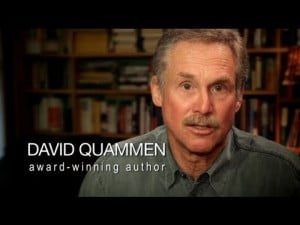
One of the benefits of living in a smallish town with an independent bookstore is when a local author has a new book release, there will be a book signing. That was what led me to the Country Bookshelf last week to hear David Quammen read from “Spillover: Animal Infections and the Next Human Pandemic” — a book six years in the making.
I respect Quammen for the amazing scientific journalist he has always been, from “The Song of the Dodo,” “Monster of God” and “The Reluctant Mr. Darwin,” plus many essays. But this time he writes of zoonotic diseases, those that leap from animals to humans, and how human interference with nature often precipitates that leap.
Quammen is a superb writer and what might have been a dull scientific tome is actually a page-turner. “Spillover” is divided into nine sections, each the story of how an emerging virus broke out of the wild to infect humans. The stories are real, the science accurate and the suspense gripping.
I was hooked by “Pale Horse” involving the Hendra virus, named for the horseracing area of Australia where it killed one veterinarian and a dozen horses and sickened a trainer/breeder, who survived to tell the tale. The sleuth who helped unravel the mystery was a student of ecology and how he traced the disease to bats is an amazing story of itself.
In some ways the book echoes a recent piece by Jim Robbins, “The Ecology of Disease” which appeared in the New York Times on July 14. Robbins’ point: “Disease, it turns out, is largely an environmental issue. Sixty percent of emerging infectious diseases that affect humans are zoonotic — they originate in animals. And more than two-thirds of those originate in wildlife.”
This, to some extent, puts emerging diseases in the realm of scourges we might be able to control or prevent. If, as Robbins and Quammen suggest, outbreaks follow disruption of the environment, it may be possible to develop wild lands in a more intelligent way.
Viruses that cause disease have flourished there and the animals that have evolved with them are seldom affected. What’s needed to create a pandemic is spread of the virus to species that have had no contact with it.
Bats, for instance, have evolved with the genus of henipah (including Hendra and Nipah) “experiencing little more from it than the fruit bat equivalent of a cold,” Robbins writes.
The sequence goes something like this: Fruit bats (also known as flying foxes) are lured from their native habitat (forests or jungles) into suburban landscapes where they come in contact with a species (horses in the case of Hendra) that has not co-evolved with the virus.
The new host then “amplifies” the virus allowing it to jump to humans.
West Nile Virus, which came to the U.S. from Africa, spread because its favorite host turned out to be the American robin, a suburban denizen. Mosquitoes, the vector that spreads the disease, find robins especially appealing, according to Robbins.
From HIV, Lyme disease, SARS, malaria, plague to common influenza, which mutates annually and can infect millions, to Ebola and dengue fever, disease seems most often to spread following incursions into wild areas of jungle and forest often to build roads or open land to agriculture and livestock production.
“Teams of veterinarians and conservation biologists are in the midst of a global effort with medical doctors and epidemiologists to understand the ecology of disease,” Robbins explains. A project called Predict, financed by the United States Agency for International Development, is working to figure out where the next diseases are likely to spill over into humans and to stop them before they spread.
And a study released last summer by the International Livestock Research Institute found more than two million people are killed each year by diseases spread by both domestic and wild animals.
Another organization doing related work is the Montana Environmental Information Center, which Quammen joined in 1980. He says he is motivated by the conservation of all species, not just humans. “The loss of biological diversity is one of the worst impacts we are having on our planet.” An echo of E.O. Wilson, perhaps.
Whether one reads “Spillover” to follow the science or solve the mystery of disease and how it’s spread, they should find the book exciting and informative. And activists who rail against development of wilderness to protect natural landscapes may find a new impetus for their cause.